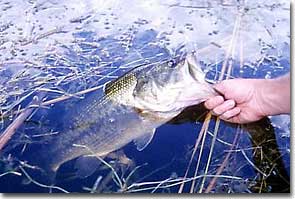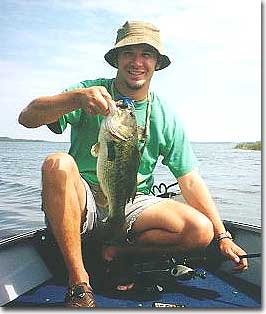Reading the Weeds to Bassin’ Success
Reading the Weeds to Bassin’ Success
By Justin Hoffman
 Whether it means casting a topwater bait or hopping a worm, the largemouth bass has an uncanny way of luring us to the lake year after year. You may, however, be missing out on some of the hottest action if you fail to poke and prod the large expanses of weed and bulrush that exist on your favorite body of water. These plant structures hold an extraordinary attraction to largemouth, and some of the biggest fish you have ever encountered call these little gems home. Here are three patterns to concentrate on – all proven producers of big largemouth bass. Floating Weeds Whether it means casting a topwater bait or hopping a worm, the largemouth bass has an uncanny way of luring us to the lake year after year. You may, however, be missing out on some of the hottest action if you fail to poke and prod the large expanses of weed and bulrush that exist on your favorite body of water. These plant structures hold an extraordinary attraction to largemouth, and some of the biggest fish you have ever encountered call these little gems home. Here are three patterns to concentrate on – all proven producers of big largemouth bass. Floating Weeds One thing to keep an eye out for when scanning a lakes' shoreline is the presence of floating weeds. These weeds are chewed up by outboard motors and proceed to be blown, or washed up against, cattails or bulrush. Find an area with lots of rooted vegetation and blown-in weeds, and you may have stumbled across a veritable bass factory. I have found it best to base my approach on the angle of the sun, as this has the most direct effect not only on bass location, but on bass behavior as well. I will usually start the day early, when the sun is still low on the horizon, looking for bass prowling out from the edge of any floating weeds that are present. The largemouth will generally move back and forth, parallel to the shoreline, chasing and actively feeding on prey. This is when fast-moving lures are your best choice, including buzzbaits, spinnerbaits and twitch baits. Stay well out from the area you intend to fish, and use long casts, as this will significantly decrease your chances of spooking any fish present. As the sun climbs higher in the sky and begins to penetrate the water with more intensity, largemouth slowly retreat back under the canopy of floating weeds. Weather dictates just how deep into the cover bass will travel. Extremes in weather, whether we are talking about bright, hot sunshine or severe cold fronts, have the same effect – it pushes them way deep into the cover. Overcast or rainy days have the opposite effect, leaving largemouth stationed out towards the weed edge, waiting to strike at whatever passes by. During these prime times, the only rod I reach for is the flipping stick; coupling it up with either a flipping jig, texas-rigged worm or lizard. If the fish are on the outside edge, you are best to choose a flipping jig as these fish will be most active, and the bulk of the jig, combined with the drop rate, will be the best triggering device.  A worm or lizard is better for those fish that are pushed farther into cover. These texas-rigged baits can be dropped through any holes in the weeds much easier due to their profile, and will appeal to those fish in a neutral or negative mode because of their slim shape and slow-jigging motion. Undercut Banks A worm or lizard is better for those fish that are pushed farther into cover. These texas-rigged baits can be dropped through any holes in the weeds much easier due to their profile, and will appeal to those fish in a neutral or negative mode because of their slim shape and slow-jigging motion. Undercut Banks Floating weeds are not the only place to try this approach. It also works anywhere that weed banks are eroded and undercut. The one key to recognize, and find, while scouring your lake is to search out undercut vegetation that has some sort of sub-surface lead-in cover. This can be anything from milfoil to coontail, but the advantage it holds is that it creates a safer environment for the bass, and a disguise for moving to and from cane beds. Through all of my days on the water, I’ve concluded that the best spots on the lake will have at least two feet of water underneath, (with three or four feet being an optimum depth), a good assortment of lead-in cover, a mixture of sand and weed bottom, and wind and wave action blowing directly into it. This does sound like a lot to uncover, but finding cane with all of the above present will produce unbelievable bass. There are a number of different tools I use in order to fish undercut banks thoroughly and precisely. The weapons of choice are the jig and pig and texas-rigged lizard. Both baits work wonders at fishing this type of cover, yet each has its own place and time. For spots with sparse lead-in cover or little bottom vegetation, I will generally reach for a jig and pig. This lure allows me to fish productive areas faster than a lizard, and is best used in conjunction with active fish. If I am faced with dense lead-in cover, or blown-in slop or pads, then a switch over to a weedless lizard will often be the key. This bait allows the angler to thoroughly probe the area, and get into tight spots that the jig and pig just cannot penetrate. It is also the best bait to choose if the fish are slightly passive, as the smaller profile and less intrusive entry will attract “negative” biters. Reeds Bulrush, or pencil reeds as some anglers call it, is an interesting plant as it provides no real cover or shade, yet it still attracts bass under certain conditions. Prime times to hit reeds would be during overcast or rainy days, during morning or evening periods and during the late summer and fall periods. Bass like to roam through reeds while feeding, but they very rarely take up residence, as there is not enough cover to provide safety or comfort to them. During the prime times, however, bass definitely relate to reeds, and are caught in good numbers. A slightly different approach is needed, in comparison to the other two types of vegetation, in order to attract and hook these fish. The majority of bass that relate to reeds will be active, so therefore fast-moving baits, preferably quite weedless, are the way to go. My number one choice for reeds is either a spinnerbait or buzzbait, which I work in tandem. Cast parallel to the outside edge of the reeds with a buzzbait to pick off any fish lingering in this open zone, then progressively work deeper into the reed bed itself, yet this time with a spinnerbait. Most spinnerbaits will ride nicely through reeds without hanging up, and the flash and vibration is key to getting the fishes attention. Working around the edge of the reeds with the boat, then moving towards the middle of the reeds will ensure that you cover the entire area, and will increase your chances of connecting. Sunny days are the one time I overlook reeds, as they historically haven’t held many bass during this period for me. There may be one or two fish present, but your best bet is to search out one of the other types of vegetation that have a guaranteed sunny-day bite. Refining Your Approach As with any type of fishing, it pays to keep an eye out for the little things that can make a difference. This certainly applies to picking fishing spots. Watching for little extras that might make an average spot just a little more attractive to a bass – things like duck blinds, logs or fallen trees – can really pay off with more and bigger catches. Paying attention to detail also applies to your baits. Anything you can do to make your offering more attractive to a bass is worth the effort. The addition of a scent always works, if for no other reason than its tendency to make bass hold the bait longer, improving your chances of a solid hook-up. For the last few years I’ve had tremendous success using a Riverside product called RealCraw, that has definitely done its job in helping me hook more lunker bass. Rattles are another great addition to your bait. Given the poor visibility in some of these weedy areas, bass often respond well to sound, and the addition of a rattle can increase your odds substantially. Discover the wonders that vegetation holds, and reap the rewards of the bass it conceals. With a little searching and refinement of tactics, this season will promise to be the one that the bass gods shine down on you, and you’ll have your best chance of hooking that hawg you’ve always dreamed about.
|
